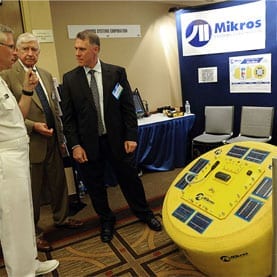
Stray heat, electromagnetic fields or even mechanical sources can provide power for portable electronics and other devices
Disposable and rechargeable batteries that power tens of millions of portable electronics could become obsolete over the coming decades as new technologies come to market that can convert ambient energy into usable electric power, new research shows.
The concept, known as “energy harvesting” (EH), is becoming more viable as technology firms bring products to market that can transform electromagnetic, thermal and mechanical energy sources into power that can be stored and used.
“In the near future, EH technology will power an increasing number of consumer and industrial products that are untethered or need to become disconnected from electrical outlets,” researchers with Navigant Energy said in a recent published report on the technology. Moreover, EH systems “offer an inexpensive and compact way to power portable electrical devices that in many cases rely heavily on batteries.”
According to Navigant, sales of such devices should roughly double over the next seven years, from less than 10 million units sold this year to an estimated 18.7 million units by 2020. Revenues generated by the development and deployment of energy harvesting devices should grow from $268 million in 2013 to $375 million by 2020, the report states.
Products and applications that are already seeing adoption of EH technologies include mobile phones, portable computers and motor vehicle electric systems. Those markets are expected to grow over the coming years, according to researchers. But EH technology can also be scaled to support much larger systems such as building lighting, medical devices and equipment, and even satellites.
“Consumers and industries alike consider the environmental and economic costs of changing and maintaining batteries to be excessive,” Eric Woods, research director with Navigant Research, said in a statement. “It is just a matter of time before they are no longer willing, economically or otherwise, to change and maintain batteries to the extent that they have traditionally done, and move toward increasingly available energy harvesting technology.”
Energy resources that allow for EH applications include electromagnetic radiation, solar and thermal energy, and mechanical energy, according to Navigant. The ambient energy stored in such resources undergoes a “transduction” process using photovoltaic, thermoelectric, piezoelectric or electrodynamic processes, allowing the energy to be turned into moving electrons and consumed.
Windup laptops and wireless light switches
In one recent application, scientists with Pittsburgh-based Disney Research developed a paperlike energy storage system that can be harvested via rubbing, sliding or tapping. The resulting energy is sufficient to turn on light-emitting diodes, activate a computer display or run other low-demand electronic devices.
Go deeper with Bing News on:
Ambient Energy
- How Pacific Drive Pulls Off Being Unnervingly Spooky And Relaxingly Chill All At Once
Leveraging a weird world, a moody drive through the woods, and a ton of spooky sounds, Pacific Drive creates vibes that are uncanny, unsettling, and sometimes, easygoing.
- Georgia Tech and Meta Create Massive Open Dataset to Advance AI Solutions for Carbon Capture
To avoid catastrophic climate impacts, excessive carbon emissions must be addressed. At this point, cutting emissions isn’t enough. Direct air capture, a technology that pulls carbon dioxide out of ...
- Great River Energy Unlocks Hidden Transmission Capacity
By installing sensors to perform dynamic line ratings, the utility’s transmission line capacity improved more than 25%, nearly 70% of the time.
- Baselode Energy Starts Drill Program on Bear Uranium Project : Begins Fleet Space Technologies' ANT survey over ACKIO
Bear drill program has started targeting 3 areas with 6 to 8 drill holes Fleet Space Technologies' Ambient Noise ...
- DOE asked to manage peak power demand
The Philippine Energy Efficiency Alliance (PE2) called for a strategic shift to address the tight power supply by managing peak demand as a prerequisite to planning new generating and transmission ...
Go deeper with Google Headlines on:
Ambient Energy
[google_news title=”” keyword=”Ambient Energy” num_posts=”5″ blurb_length=”0″ show_thumb=”left”]
Go deeper with Bing News on:
Energy harvesting
- Exploiting disorder to harvest heat energy: The potentialities of 2D magnets for thermoelectric applications
Thermoelectric systems are a green and sustainable way to harvest energy from any form of heat that otherwise would be wasted. At the core of this energy conversion process is the so-called Seebeck ...
- What’s that?…A fuel cell that harvests energy from…dirt?
A soil microbial fuel cell where microbes in dirt could power applications which are literally “in the field”.
- Saudi Arabia Energy Harvesting System Market Focus Group Alchemy Transforming Conversations into Strategic Gold
Request To Download Free Sample of This Strategic Report @ https://reportocean.com/industry-verticals/sample-request?report_id=SA1478 The report covers market ...
- This salt battery harvests osmotic energy where the river meets the sea
Estuaries -- where freshwater rivers meet the salty sea -- are great locations for birdwatching and kayaking. In these areas, waters containing different salt concentrations mix and may be sources of ...
- Energy Harvesting System Market Poised for Remarkable Growth, Projected to Reach USD 1317.56 Million by 2031
The Energy Harvesting System Market demonstrated a robust valuation of USD 638.86 million in 2023. It is projected to experience substantial growth, reaching USD 1317.56 million by 2031. This growth ...
Go deeper with Google Headlines on:
Energy harvesting
[google_news title=”” keyword=”Energy harvesting” num_posts=”5″ blurb_length=”0″ show_thumb=”left”]









